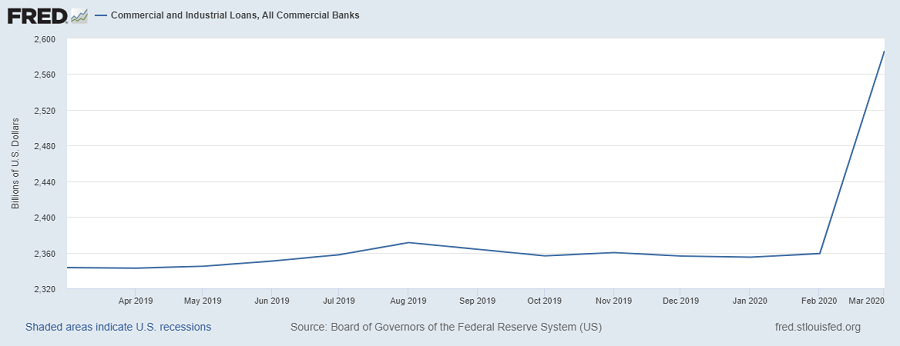- Oz Lindley Joins Pathward’s Commercial Finance Team
- Opening Doors: How SFNet’s Guest Lecture Program Connects Students to Careers in Secured Finance
- Building the Future of Asset-Based Lending at SLR Capital Partners: An Interview with Mac Fowle and Cedric Henley
- The Cost of Uncertainty
- The State of Lender Finance
Managing C&I Risk in a Time of Pandemic
By Patrick Trammell
Commercial lenders will face many new and unique challenges over the coming months as the full effects of the coronavirus pandemic are felt throughout the economy. For commercial customers cash flow, liquidity, and credit tightening dramatically across industries is the new normal. In these uncertain times, no segment of the bank commercial portfolio is under as much short- and long-term risk as the commercial and industrial (C&I) line of credit segment.
According to the Federal Reserve, beginning in late mid-March, C&I loans surged at the highest rate in 73 years. The week of March 27th saw a huge $200-billion dollar spike in that week alone. Clearly, this indicates commercial borrowers drawing down excess borrowing capacity to build cash reserves.

The nearest phenomenon to this borrower behavior was the Great Recession of 2008, however, there are important differences. The Great Recession was caused by an asset bubble in the financial markets. The pandemic is a full-blown economic recession, which creates dynamics specific to C&I credit risk:
• Top-line revenue declines of 40/60% or more.
• Extended payment cycles throughout the cash cycle.
• Potential supply chain disruption.
• Unstable employment outlook.
Evolving Risk Profiles Indicate Need for Enhanced Oversight
The standard C&I bank line of credit is generally monitored by a monthly borrowing base certificate, and governed by standard financial covenants, such as fixed-charge coverage, debt to worth, guarantor liquidity, and material adverse change provisions. For many years, C&I credit professionals have used some variation of the following characteristics to delineate monthly reporting from more intensive oversight:
• Debt/worth < 3:1
• Consistent and strong monthly profitability
• Conservative advance rates on collateral (A/R<80%/Inv.<40%)
• Robust excess line of credit availability (> 30/40% of Line Balance)
In a normal economic environment, this level of oversight of the C&I line is an appropriate part of “Managing the Relationship.”
Federal Reserve statistics indicate significant increases in borrowings, at the same time that revenues are declining at alarming rates. This would indicate that “Robust Excess Line of Credit Availability” is certain to evaporate for many bank borrowers. Early statistics show similar erosion in covenant compliance and profitability as well.
To prepare and respond to the issues listed above, lenders and credit professionals should consider implementing plans with their C&I borrowers which both protect their current loan position and anticipate borrower needs in the short, intermediate, and longer term. C&I lending requires a continually open, honest, and transparent business relationship between the lender and the borrower. Depending on the structure of the loan, the lender may have monthly, weekly, or even daily discussions with the borrower about draws, repayment plans, and current business issues.
Lenders and credit professionals should immediately consider analyzing and stress testing at the customer level in as much detail as possible by performing the following actions:
• Request and review an updated borrowing base certificate
• Request and review backup collateral information, including accounts receivable aging and inventory listings
• Requesting and reviewing updated financial statements for company and guarantors
• Review covenants, material adverse changes, and grace periods
• Review availability of additional collateral (from company or guarantor) to support current borrowings.
• Assist, when possible, in obtaining additional financial resources (SBA, PPP, Emergency Disaster Loans, Vendor Support, etc.)
Risk Level Structure and Reporting Adjustments
Changing economic conditions might very well create the necessity for adjustments in structure of existing C&I facilities. Characteristics which might indicate the appropriateness of tighter controls include the following:
• Debt/Worth > 3:1
• Inconsistent, marginal profits, or losses on a monthly basis
• Aggressive advance rates on collateral (A/R>80%/Inv.>40%)
• Limited excess line of credit availability (< 25/30% of line balance)
• Over advance of line of credit balance to collateral availability
In the case of one or more of the above noted signs of C&I loan deterioration, tighter controls may be employed to protect the Lenders position, and assist Borrowers in more intensive focus on cash management. These tighter controls may include:
• More Frequent Borrowing Base Reporting (Bi-Monthly, Weekly, Daily)
• Lender may assume more Control of Cash (Lockbox/Blocked Account)
• More Frequent Supporting Documentation (Detailed A/R, Inventory Reports, Sales Journals, etc)
• Availability Driven Defaults
• Additional Collateral, Enhanced Guarantees, or additional Guarantors
In uncertain and contracting economic times, the level of oversight of the C&I line must necessarily be adjusted from “Managing the Relationship” to more intensively “Managing the Line of Credit.”
Keys to Success
By all accounts, the pandemic crisis and its effects on the economy will be deep and extended. Perhaps no segment of the financial markets is more at risk for commercial banks than the C&I segment. These times will require clear thinking, purposeful decision making, planning, and execution. Clear and consistent communication between lenders and borrowers is imperative to allow bankers to protect their institution’s balance sheets while providing borrowers the best opportunity to weather this downturn. There is much that is out of the control of the most diligent bankers, and the best business people. There is however much within the control of both. Experienced bankers don’t have crystal balls, however, by communicating effectively and adhering to best practices they can help both their institution and valuable customers in navigating this process.


